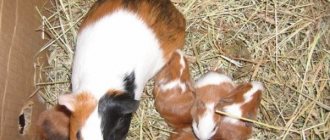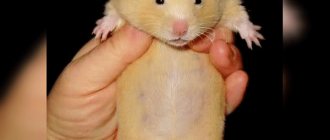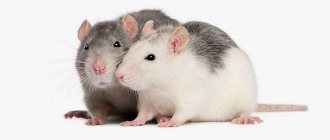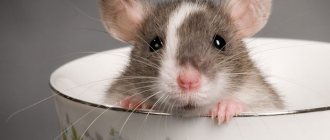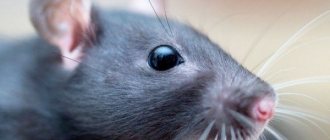Rats get pregnant quickly and easily, so there is a good chance of bringing an unexpected bonus with your new pet from the pet store.
In addition, some owners buy opposite-sex couples to live together, which can result in pregnancy. However, they are not quite prepared for the consequences that arise in this case.
Let's look at how to determine a rat's pregnancy, how long it lasts, how many babies appear at a time, and how childbirth occurs.
Puberty and mating
On average, the lifespan of a decorative rat is 2.5-3 years. In such a short period of time, the animal must have time to give birth to offspring. Therefore, puberty in rats begins very early. In males - at 5 weeks, in females - at 6 weeks.
However, at such an early age it is better to avoid pregnancy. Because for a young, fragile female body this is a very heavy load, which can lead to adverse health consequences, including the death of the animal.
Too late first birth is also undesirable, since the offspring may be born weak and sick. The optimal age for reproductive function is 6-8 months.
Upon reaching the age of 5-6 weeks, males must be removed. Otherwise, upon the onset of puberty, they will immediately begin mating with all their cagemates, even with blood relatives.
Habitat
They prefer to live in basements, sewer pipes, garbage dumps, port facilities, and in some cases they inhabit the first floors of buildings. They can be found not only on the first floors, but also in the attics of buildings. However, in the latter case, the presence of rats on the top floors is not in the nature of settlement, but is a temporary inspection of the territory.
The choice of habitat is related to the structural elements of the building: the presence of easily chewable sound and heat insulating materials. Spaces behind suspended ceilings and technical corridors also become places of settlement. If there are garbage chutes in buildings, first of all, the premises near the garbage chutes are populated: basements and structural elements of buildings associated with the garbage chute. They can make burrows under container platforms.
Nests are built from various debris, and the nest is divided into sections: food storage, nesting, emergency exits. They need water to survive, so they establish their colonies close to water sources, as close to them as possible. In colonies there are dominant and subordinate individuals. Some colonies may number hundreds of individuals. Despite popular belief, rats are not aggressive and attack only in conditions of starvation and when life is threatened.
Rat settlements are represented by groups, each of which occupies a certain territory and differs in the number of individuals included in its composition. Each settlement has its own activity zone and research zone. In the activity zone, feeding occurs and the bait is eaten first, as a rule, this is the area near garbage disposals. The study area can extend vertically and horizontally in occupied buildings and is characterized by irregular movements of rats.
In summer and winter, there is a seasonal decline in rats in buildings - this is due to the colonization of open areas in the warm season and the death of offspring in the winter.
How to tell if a rat is pregnant
Often, rat owners find out that their pet is pregnant on the day of birth, and in a state of shock they do not know what to do. True signs signaling an interesting position of the female will help you avoid such troubles:
- No heat . Normally, it occurs in the female once every 5 days and lasts 12 hours. During this period, the baby arches, lifts her muzzle, shaking her ears. And the loop increases, becomes moist and slightly open.
- Changes in behavior . Pregnant rats often display uncharacteristic aggression towards their cagemates. Active animals can switch to a measured lifestyle. But calm people, on the contrary, fuss and show anxiety.
- Changing taste preferences . While carrying pups, females switch to more nutritious food - meat, nuts, seeds, grains. And they may completely refuse their favorite light treats (fruits, vegetables, wooden sticks).
- Active weight gain . At the initial stages, you might think that the animal simply gained weight due to good nutrition. However, by the end of the 2nd week, you will notice a greatly grown belly against the background of a thin muzzle and upper body.
- Nesting . Closer to giving birth, the rat begins to arrange a future home for the rat pups. She begins to drag rags, pieces of paper, hay - everything soft and warm - to the chosen place.
A couple of days before the expected date of birth, you need to remove the filler from the cage, which is dangerous for the baby rats. Its small granules can enter the respiratory tract of babies and cause suffocation.
It is better to replace the filler with regular toilet paper. It is completely safe for offspring, hypoallergenic, breaks well, and retains heat.
Hygiene
While your rat is pregnant, be sure to keep the cage clean. Cleaning should be carried out at least every 5 days. The last cleaning should be done 5 days before the start of labor, by thoroughly washing all the equipment and scalding it with boiling water.
The house and tray should be disinfected and the filler replaced. The bedding must always be kept clean and dry so that the animal does not inhale harmful fumes of ammonia and hydrogen sulfide. Please note that you can only wash the cage using baking soda; household chemicals are prohibited.
Caring for a pregnant rat
During pregnancy, females are especially vulnerable. Not only their physiological state changes, but also their psychological state. Therefore, for the normal course of pregnancy, it will be necessary to provide the expectant mother with proper care.
Content
To ensure the rat's comfort, the following measures will need to be taken immediately after pregnancy is detected:
- Move the pet into a small cage, inside which there should be no play complexes, labyrinths, or running wheels. All interior items (house, drinking bowls, feeders) must be firmly secured.
- It is better to replace the usual filler with paper napkins or toilet paper.
- Move the cage to a remote room where the animal can hide from prying eyes and feel safe. At the same time, you need to take care of the microclimate in the room - it should be warm and dry inside, and you should also protect the fluffy from direct sunlight.
- The cage will need to be cleaned twice a week. During hygiene measures, the pet will have to walk around the room. It is not recommended to use detergents to wash the cage itself and everything in it. Safe baking soda will do the job perfectly.
After determining the rat’s permanent place of residence during pregnancy, under no circumstances should the cage be moved to another room or even to another place. Constant moving will cause discomfort to the animal.
Feeding
The diet of a pregnant rat is noticeably different from the menu of other pets. After all, the expectant mother needs a lot of energy and building material to carry rat pups normally. Therefore, nutrition for a pregnant female must be organized taking into account the following features:
- The basis of the diet, as before, should be grain. It is necessary to choose grain crops for feeding taking into account the preferences of the pet.
- As a source of protein, you need to give the rat more animal products - offal, lean meat, chicken cartilage, fish, shrimp, fermented milk products - low-fat cottage cheese, kefir.
- During the period of bearing babies, the rat needs more vitamins. Therefore, her menu needs to include a sufficient amount of fresh vegetables (zucchini, pumpkin, broccoli) and fruits (apple, banana, pear).
- During pregnancy, rodents often experience gastrointestinal disorders. To avoid digestive problems, you need to give your fluffy more fiber. Its natural sources are fresh grass (dandelion, plantain, fodder lettuce, parsley, dill).
Also, for a good metabolism, a pregnant female needs a large amount of fluid. Therefore, fresh water should always be available in drinking bowls.
The following foods are strictly contraindicated for pregnant rats: bell peppers, egg yolks, sour tomatoes, white cabbage, radishes, grapes, fresh milk.
Drinking fountain
Such a device can serve not only to quench the thirst of animals, but also become an original accent in the home interior. The design consists of a water bowl, a filter, a diffuser and a drinking bowl located at the top. Additionally, it is equipped with a decorative sprinkler, especially popular with native breeds (Maine Coons, Kuril Bobtails, Siberian cats).
Continuous circulation of liquid is ensured by a mini-pump powered by a USB cable. More advanced models may contain backlighting and an indication of the level of remaining water in the tank.
Cost – 2400 rub.
How long does pregnancy last
To thoroughly prepare for childbirth, you need to calculate the approximate date of the exciting event. On average, a rat's pregnancy lasts 3 weeks from the moment of fertilization. However, the timing may vary depending on the number of babies.
Rats carrying 6-7 pups can give birth earlier - on the 19-20th day. And if 17-20 rat pups are planning to be born, delivery may be delayed until 22-23 days. Carrying offspring for more than 24 days is a reason to contact a veterinarian. Prolonged pregnancy in rats often signals problems.
Lifestyle
Elephants are considered the largest animals that can be found on land. These giants belong to the class of mammals and are very social animals. Their natural habitat is Southeast Asia and Africa.
Elephants live in families, and complete matriarchy reigns in families, and males are expelled from the herd at a young age (or they leave on their own). Adult males live solitary lives and approach the family only to mate with a mature female. An elephant family consists of the eldest elephant, her daughters (with children) and other female relatives.
By nature, elephants are nomads. It is the eldest female who leads her family in search of food, and she decides where to go, where and how long to rest.
These huge animals are very sociable and enjoy communicating with their own kind. Tactile contact plays a huge role in the life of giants. They touch each other with their trunks, stroke them as a sign of greeting, the older ones kick the younger ones as punishment
Members of the same family treat each other with great care; special care and attention is given to a sick or dying elephant
The question of how long pregnancy lasts in elephants has long remained controversial in scientific circles. But today, thanks to the observations, research and documentation of zoologists, much is known about the pregnancy period, childbirth and subsequent care of the baby of these powerful herbivores.
Possible problems and complications
Typically, rats cope with labor on their own and do not require additional assistance. However, no one is immune from possible complications. The following signs indicate problems:
- bloody or purulent vaginal discharge;
- complete absence of movement when palpating the abdomen before childbirth;
- animal apathy, refusal of food and water;
- prolonged labor – longer than 5 hours;
- the female gave birth to several babies, but does not show attention to them - probably several more rat pups got stuck passing through the birth canal.
If you detect at least one of the listed signs, you must immediately take your pet to the veterinary clinic. Surgical intervention may be required to save the rat.
Sometimes rat pups are born in the amniotic sac, and the weakened mother is not able to free the newborns on her own. In such a situation, you should not waste time going to the veterinarian - you can help the furries yourself. To do this you need:
- clean your hands with alcohol;
- wrap the index finger and thumb with a sterile bandage;
- gently pick up the baby in the shell with bandaged fingers;
- with the other hand, cut the amniotic sac using nail scissors and release the baby rat;
- use gauze to remove accumulated mucus from the baby’s mouth and nose.
If all manipulations are carried out correctly, the little rat should squeak. You will also need to cut the umbilical cord and treat the wound with chlorhexidine.
Changes in behavior
Pregnancy changes the hormonal balance in female rats, which can sometimes cause changes in behavior. Your once docile rat may become more aggressive and territorial towards both people and other rats. An eccentric or aggressive female may become calmer.
Once pregnant, the female rat also shows no interest in males. A pregnant female will not react in any way to the smell of a male. A fertilized rat may also be more interested in food and steal from other females, and may be more protective of its food and hide it.
Preparing for childbirth
Childbirth is a complex and responsible process, so you need to carefully prepare for the birth of babies. The only thing the owner can do to help a rat during delivery is to create comfortable conditions. To do this you need:
- curtain the windows, creating twilight in the room; you can also shade the cage using cardboard;
- eliminate even the slightest draft in the room;
- take care of a comfortable air temperature of +20-21ᵒС;
- Provide the cage with plenty of paper and fill the drinking bowls with water.
To prevent the rat from becoming nervous during childbirth, you should not stand over the cage and observe this intimate process. It's better to leave the room for a couple of hours. The pet itself will cope perfectly with the birth of babies.
Factors affecting reproduction
In the wild, the number of times a rat gives birth per year is influenced by climatic conditions, availability of food in the right quantities, natural disasters, and environmental conditions. We must not forget that natural selection allows only strong cubs to survive.
At home, despite the fact that rats are not so dependent on external factors, breeders try to limit the number of pregnancies, since frequent births affect the health of pets.
The birth of healthy rat pups and their number are influenced by the air temperature in the apartment, humidity, balanced nutrition, and stressful situations. Genetic factors also play a role. Spontaneous mutations and hidden recessions may occur.
Birth of baby rats
On average, birth in rats lasts 2-3 hours. Before the onset of labor, a mucous plug emerges from the genital tract, which throughout the pregnancy protected the offspring from infection. During childbirth, the rat sits down on its hind legs and helps the pups to be born. The interval between the birth of cubs is 5-7 minutes.
The female independently gnaws the umbilical cord and carefully licks the born rat pups. Quick movements with a warm tongue stimulate blood circulation and help open the lungs. After completing hygiene procedures, the new mother gathers her newborn babies into a pile and begins breastfeeding.
A rat has only 12 nipples, and the cubs often have 14-16. Therefore, rodents practice alternate feeding of rat pups, which is impossible with insufficient lactation.
If a newborn rat does not move, does not squeak, and does not show any signs of life, the rat simply eats it.
Veterinary intervention
At a veterinary practice, specialists may do an x-ray or ultrasound to see how many babies are left in the uterus, as well as their position. The female does not need to be sedated for x-rays.
- Oxytocin injection
Your veterinarian may try to induce labor with oxytocin. This is especially helpful for postpartum-exhausted rats whose contractions have become too weak to produce pups.
Oxytocin is a hormone produced by the pituitary gland that increases the ability of sodium molecules to pass into the muscles of the uterus, causing the uterus to contract. These muscle contractions move the babies through the birth canal. Oxytocin is also necessary during lactation. Oxytocin, given by your veterinarian, is a synthetic hormone that is used if your rat is having weak or no contractions.
Caution should be exercised when prescribing oxytocin. If the baby rat is positioned incorrectly or its large body is stuck in the birth canal, the stronger contractions produced by the medicine may cause the uterus to rupture. An x-ray will help your veterinarian visualize the babies' position and decide whether an injection of oxytocin is needed.
In some cases, labor begins after the first injection, but slows or stops again. In this case, repeat dosing may be necessary to ensure that all babies can be born. Oxytocin should not be administered to a rat during labor more than two or three times.
- Emergency caesarean section
A Caesarean section is a procedure in which the offspring is born by cutting the abdomen and uterus, as opposed to a normal birth.
Since it is impossible to give birth to babies and repair the uterus in rats, the procedure is a virtual sterilization. The uterus is removed and opened to save all viable children and the mother.
Your veterinarian should use all routine sterile surgical procedures, including sterile draping. The veterinarian may pre-treat the rat with Torbutrol or Banamine (for pain) and Glycopyrrolate (for heart protection). The rats will be given Isoflurane or Sevoflurane for surgery.
A female after a cesarean section will not be able to breastfeed due to stress after the operation and lack of hormones. Ask your veterinarian to give her pain medication. You give it to a rat at home - it is a very invasive and painful procedure.
Although not every emergency sterilization results in a live birth, often some or all of the children survive. They will need help to complete the birth process.
After the hysterectomy, a veterinarian will need to care for the mother while an assistant or more will help with the offspring. This needs to be done quickly. Babies stuck in the birth sac without oxygen may struggle to breathe and aspirate birth fluids.
Each uterine horn will be carefully cut so that none of the babies are harmed. When babies are removed, each sac will be carefully opened and the umbilical cord cut approximately 3.5cm from the body. Afterwards, babies will be wiped with a warm sponge or cloth. Next, they are dried by gently and constantly rubbing. It is important to make sure their mouth and nasal passages are clean. It's normal if they don't start breathing right away; it may take a few minutes of stimulation to breathe.
It is necessary to constantly rub babies and periodically bring them to a source of pure oxygen (to an oxygen tube during rubbing). This can even revive purple or blue babies.
Caring for the rat and offspring
After giving birth, the mother rat actively protects the offspring, so in no case should you touch the rat pups with your hands. Otherwise, at best, she will bite the owner, at worst, she will eat the offspring on which the foreign smell remains.
It is recommended to carry out the first general cleaning inside the cage only after the babies open their eyes. This usually happens on days 13-15. Before this, it is recommended to gradually change the paper. Contaminated pieces are replaced with fresh ones using a regular spoon.
You also need to take care of good nutrition for the nursing mother. She should receive more meat products, fresh fruits, vegetables and herbs, nuts, and grains. Adequate nutrition will ensure good milk production.
At 5 weeks, babies can be separated from the rat. Especially boys, since at this age they have already reached puberty, and will definitely try to impregnate their mother. And the animal may simply not be able to withstand a quick repeat birth. This article will help determine the sex of the rat pups.
Pregnancy and childbirth in rats are relatively favorable and painless. But only on condition that at least 3-4 months pass between gestations. Then the pet will again be able to please its owner with a new addition to the family.
Nesting
As pregnancy nears the end, certain hormones that increase maternal behavior in rats increase as well as decrease. When these changes occur, the female begins to build a nest. You can be sure that the babies will arrive within a few days. Some females build very simple nests, while others build complex ones that completely conceal the young.
In late pregnancy, it is a good idea to provide the female with nesting material. Try to avoid fabrics with holes or ties, as these can suffocate or injure your baby. You may also consider removing the hammocks or moving the female to a single-level cage to avoid injuring the babies who might fall. (Occasionally, females will build nests and give birth on ledges, in hammocks, or in hanging pipes.)

